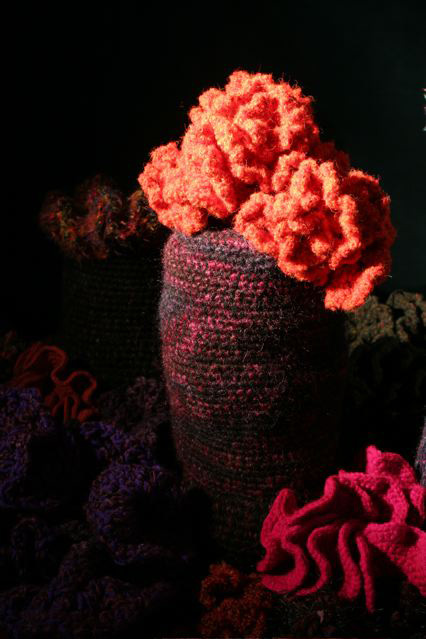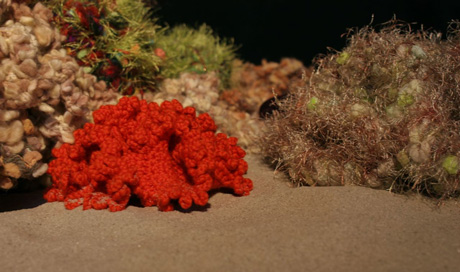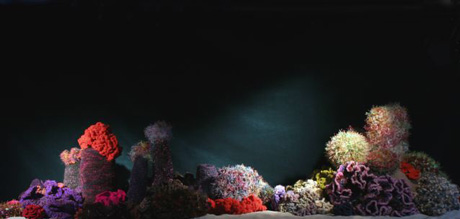Institute For Figuring
– Artist’s Website –
The Crochet Coral Reef is a project created by Margaret Wertheim and Christine Wertheim of the Institute For Figuring, a Los-Angeles based non-profit that pioneers creative new methods for engaging the public about scientific and mathematical issues by putting people and communities at the core..
The Crochet Reef project resides at the intersection of mathematics, marine biology, handicraft and community art practice, and also responds to the environmental crisis of global warming and the escalating problem of oceanic plastic trash. Crochet Coral Reef installations have been exhibited in art and science museums worldwide, including the Andy Warhol Museum (Pittsburgh), the Hayward Gallery (London), the Science Gallery (Dublin), and the Smithsonian’s National Museum of Natural History (Washington D.C.). Seen by more than three million people, the Crochet Coral Reef is now one of the largest participatory science + art endeavors in the world.
Through its Satellite Reef program, the Institute For Figuring team has held workshops and lectures on five continents to teach the techniques of reef-making – plus the related science and mathematics – to local communities worldwide. Since 2005, the IFF has been actively building this global network that currently includes some 8000 citizens in a dozen countries. The IFF welcomes new participants to the project and provides guidelines for doing so here.
The IFF welcomes new participants to the project and provides guidelines for doing so here.

The Crochet Coral Reef is a woolly celebration of the intersection of higher geometry and feminine handicraft, and a testimony to the disappearing wonders of the marine world.
Created and curated by Christine Wertheim and Margaret Wertheim of the Institute For Figuring.
One of the acknowledged wonders of the natural world, the Great Barrier Reef stretches along the coast of Queensland, Australia, in a riotous profusion of color and form unparalleled on our planet. But global warming and pollutants so threaten this fragile monster that scientists now believe the reef will be devastated in coming years. As a homage to the Great One, Margaret and Christine Wertheim of the Institute For Figuring instigated a project to crochet a woolen reef.
The sisters, who grew up in the state of Queensand, began the project in 2005 in their Los Angeles living room, and for the first four years of its life the Reef took over their house, gradually expanding to become the dominant life-form in their home. At the same time the project began to expand into other cities and countries until it has now become a worldwide movement that engages communities across the globe from Chicago, New York and London, to Melbourne, Dublin and Capetown. The Crochet Reef is a unique fusion of art, science, mathematics, handicraft and community practice that may well be the largest community art project in the world. Click here for information about how to start a Satellite Reef.
The inspiration for making crochet reef forms begins with the technique of “hyperbolic crochet” discovered in 1997 by Cornell University mathematician Dr. Daina Taimina. The Wertheim sisters adopted Dr Taimina’s techniques and elaborated upon them to develop a whole taxonomy of reef-life forms. Loopy “kelps”, fringed “anemones”, crenelated “sea slugs”, and curlicued “corals” have all been modeled with these methods. The basic process for making these forms is a simple pattern or algorithm, which on its own produces a mathematically pure shape, but by varying or mutating this algorithm, endless variations and permutations of shape and form can be produced. The Crochet Reef project thus becomes an on-going evolutionary experiment in which the worldwide community of Reefers brings into being an ever-evolving crochet “tree of life.”
As a totality, the Crochet Reef has grown far beyond its original incarnation on the Wertheim’s coffee table so that today it is made up of many different “sub-reefs,” each with its own colors and styling. Major sub-reefs include the Bleached Reef, the Beaded Reef, the Branched Anemone Garden, the Kelp Garden, and The Ladies’ Silurian Atoll, a ring-shaped installation with close to 1000 individual pieces made by dozens of our most skilled contributors around the world. In addition to these delicate woolen reefs is also a massive Toxic Reef crocheted from yarn and plastic trash – a part of the project that responds to the escalating problem of plastic trash that is innundating our oceans and choking marine life.

Each crochet model results from the application of an iterative recipe. Like fractals, such as the Mandelbrot Set, these forms come into being through the process of doing a small set of steps again and again and again. Though experience often serves as a guide, there is no way to know in advance what a specific algorithm will produce and we have many times been surprised when seemingly insignificant changes in the underlying pattern led to fundamentally new results. In a very real sense, this is a kind of experimental mathematics and we invite crocheters everywhere to explore for themselves the possibilities inherent in these techniques.
Information about these techniques and instructions for making specific forms are available in a beautifully produced handbook published by the Institute called A Field Guide to Hyperbolic Space, which may be purchased here: A Field Guide to Hyperbolic Space.
Getting started on your own hyperbolic models is easy. The basic insight is to understand that these forms result from the simple process of increasing the number of stitches in every row. The more often you increase stitches the faster the model will grow and the more crenellated the finished form will become. Models can begin with a simple line, resulting in a hyperbolic plane; or from a single point with the crochet spiraling around to gradually fan out like a cone, resulting in what is known as a pseudosphere. You may also begin from a circle, which will produce tubular, bell shaped, or trumpeted configurations.
As you explore, be playful. Don’t worry about sticking too closely to the formal rules, though it’s interesting and important to understand what the rules do. Try things out for fun. Experiment with different types of yarn. Try mixing yarns together, say a thick worsted and a fine mohair, or a silk and a cotton thread. Try varying the rate of increasing in a single model. Consider using string, wire, and plastic, or anything else that takes your fancy. Try felting – throw the finished model in a washing machine with hot water and let it churn for half an hour. This only works with pure wool (acrylics and cotton won’t felt) but the results are wonderful!







